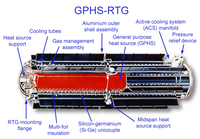
Photo from wikipedia
Abstract Thermal disassembly is prevalently applied for the removal of electronic components on waste printed circuit boards (WPCBs), and temperature is an important factor influencing the pollutant emission process. The… Click to show full abstract
Abstract Thermal disassembly is prevalently applied for the removal of electronic components on waste printed circuit boards (WPCBs), and temperature is an important factor influencing the pollutant emission process. The emission characteristics of polybrominated diphenyl ethers (PBDEs) to the environment under thermal stress were investigated by conducting both bench-scale experiments and pilot-scale experiments over a temperature range from 100 to 260 °C. Bench-scale experiments showed that the emission factors (EFs) for ∑39PBDEs from WPCB powder were obviously higher than those from WPCB fragments. Mono-to tri-BDEs predominated the PBDEs emission at each temperature, and the EFs for the mono-to tri-BDEs from WPCB powder ranged from 232 to 3280 ng/g, respectively. Pilot-scale experiments were done to study the particulate matter (PM) and PBDEs emitted from WPCBs mounted with electronic components using a thermal disassembly machine. The mass of the PM and PBDEs released from WPCBs during heating increased with increasing temperature. A bimodal distribution pattern for the PM with peaks at diameters of 0.4–0.7 and 5.8–9.0 μm was observed. The values of the EFs for ∑39PBDEs varied from 6.41 to 674 ng/g, which were comparable with those calculated from WPCB fragments in the bench-scale experiments. The mass distribution of the ∑39PBDEs in the PM predominated in the size fraction of >9.0 μm and 0.7–1.1 μm at 100 and 260 °C, respectively. The highly brominated PBDEs (hexa- and hepta-BDEs) had a mass median aerodynamic diameter (MMAD) greater than 2.5 μm, while the lightly brominated PBDEs (mono-to penta-BDEs) were mainly distributed in finer particles, with a MMAD of less than 2.5 μm. The particle size distribution of PBDEs was significantly correlated with the distribution of organic carbon (OC) in PM. All these results can provide basic data for gas pollution related to PBDEs and its control for electronic waste recycling.
Journal Title: Atmospheric Environment
Year Published: 2020
Link to full text (if available)
Share on Social Media: Sign Up to like & get
recommendations!